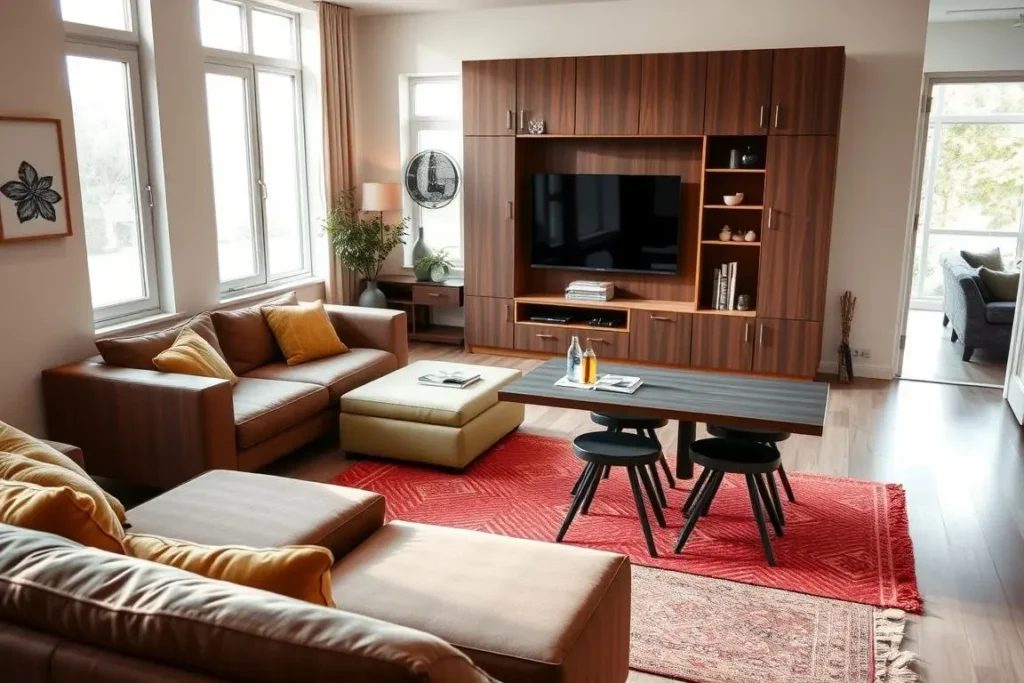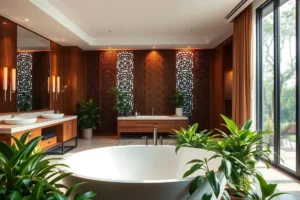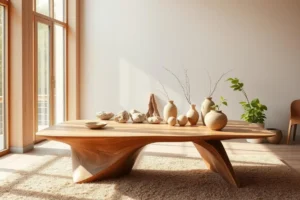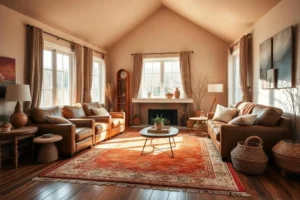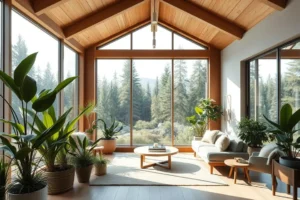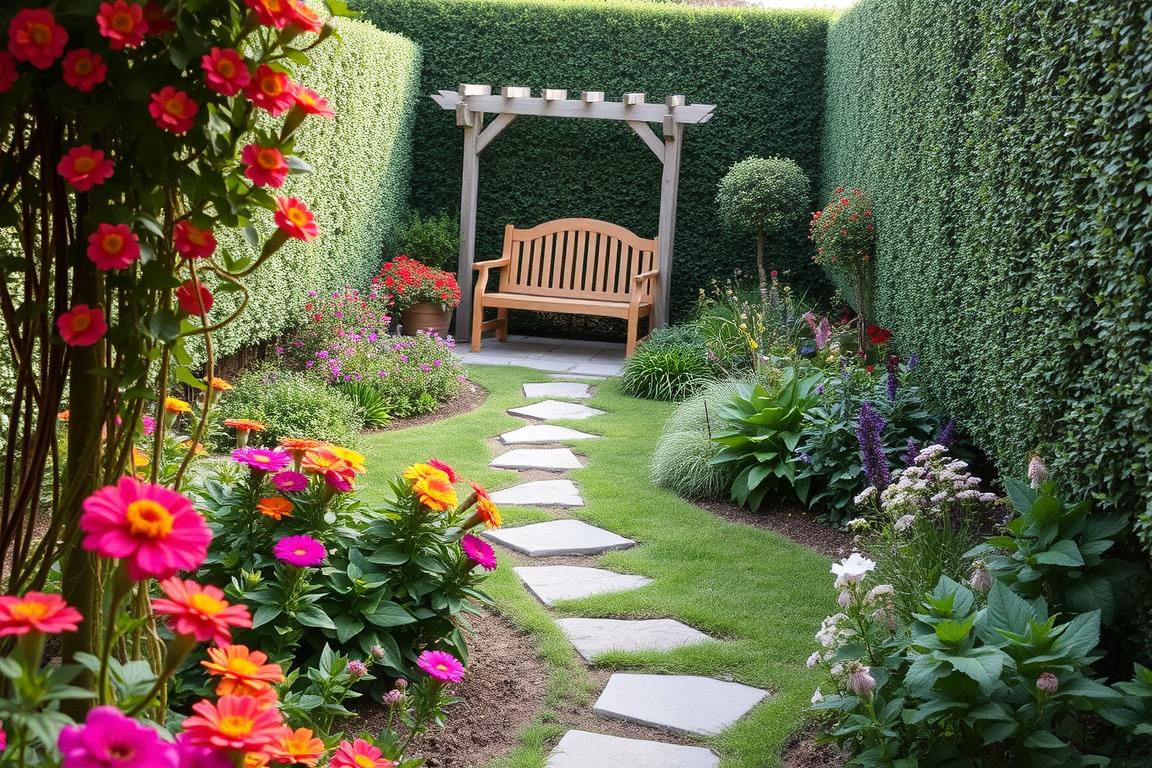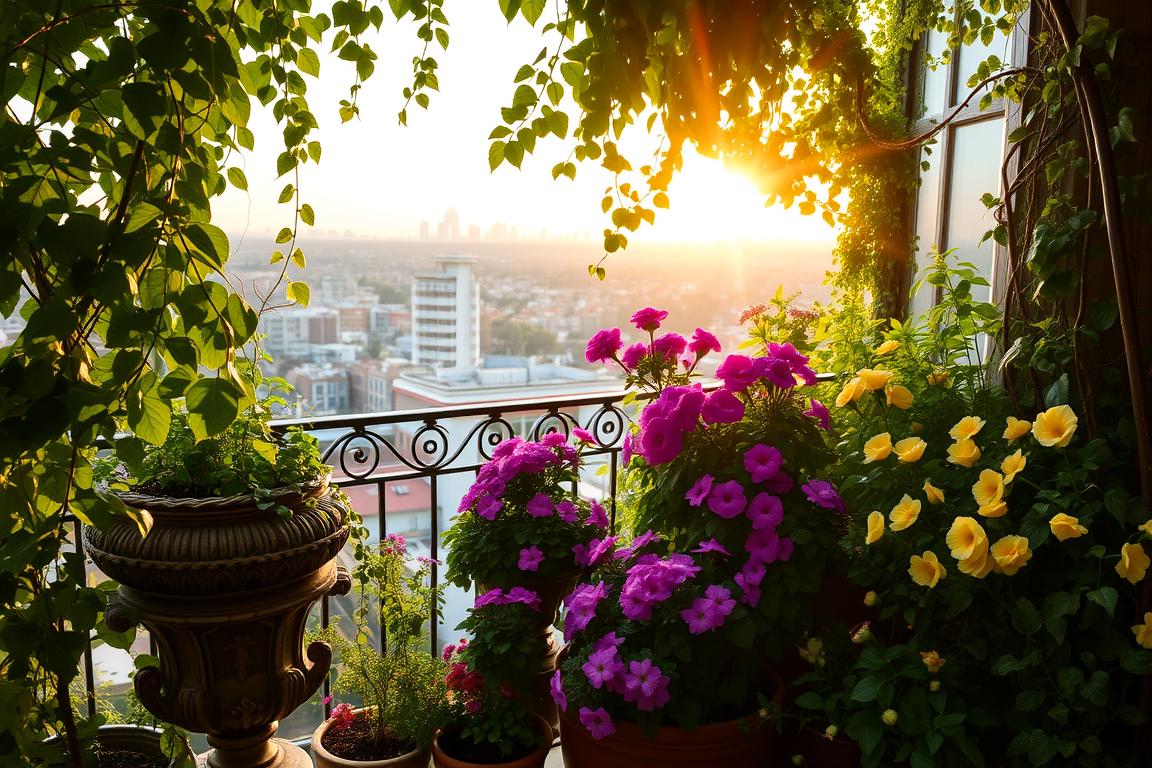Does your small apartment feel like it’s holding you back? You’re not alone. You don’t have to give up style or comfort just because you have limited space. With the right strategies, even the smallest rooms can feel big and welcoming.
Imagine stepping into a room filled with sunlight, plants, and thoughtful details. Natural design tricks can transform small spaces into places of calm and creativity. This guide will show you nine effective ways to make the most of your space using nature-inspired ideas.
Table of Contents
ToggleKey Takeaways
- Use natural light and plants to expand perceived space.
- Light colors and organic patterns create airy, open vibes.
- Strategic furniture choices save space while adding warmth.
- Earthy tones and textures bring calm without clutter.
- Every small-space design choice can make a big difference.
Understanding Natural Design in Small Spaces
Natural design turns small areas into peaceful, useful spaces. It blends elements found in nature. These small-space solutions mix beauty with function, making spaces feel open and welcoming. Let’s look at how to get this with natural design tricks.
What Is Natural Design?
Natural design uses materials like wood, stone, and plants to bring the outdoors inside. Imagine bamboo floors, woven baskets, or hanging ferns. It focuses on textures and colors from nature to bring calm and balance.
Benefits of Using Natural Elements
- Reduces stress by connecting you to organic patterns and calming hues
- Improves air quality through live plants like snake plants or peace lilies
- Enhances mood with warm, earthy tones that feel grounding
Why Small Spaces Need Special Attention
Small rooms can feel cramped or chaotic without careful planning. Natural design tricks help by cutting down on clutter and making the most of light and space. For instance, vertical gardens save floor space, and light wood tones make rooms feel bigger. Using multi-functional items like storage benches or foldable tables keeps things practical while staying true to nature-inspired style.
Choosing the Right Colors for Small Spaces
Color choices can change how small spaces feel. Room-enhancing techniques like picking the right colors make rooms look bigger and welcoming. These interior design tips suggest using light colors, natural tones, and adding depth without making the space feel crowded.
Emphasizing Light Colors
Light colors like white, cream, or pale blue help light bounce around, making rooms feel airy. Try Benjamin Moore’s “Simply White” or Sherwin-Williams’ “Alabaster” for walls. Use these colors on all walls to keep the look consistent and avoid visual breaks.
The Impact of Earth Tones
Soft greens, terracotta, or muted browns bring nature inside. For example, Farrow & Ball’s “Soybean” green on walls adds warmth while keeping the space open. Pair these colors with neutral accents to balance the look.
Creating an Illusion of Space
Paint ceilings lighter than walls to make rooms feel taller. Use color gradients, like Benjamin Moore’s “Morning Fog” to “Morning Dew,” to add depth. A table below shows some effective color combinations:
| Color | Effect | Application |
|---|---|---|
| White | Maximizes light | Walls/ceilings |
| Sage Green | Brings calmness | Feature walls |
| Light Gray | Modern and spacious | Accents |
Test colors on walls before committing. Use sample pots to see how hues look with natural light in your space.
Incorporating Natural Light
Natural light can make small rooms feel bigger and brighter. Using sunlight effectively is key to space-maximizing strategies. It can change how you see your home.
Maximizing Window Space
First, make the most of your windows. Swap heavy drapes for light fabrics like linen or mesh. Cut back shrubs and clean windows often. Add light-reflective window sills to spread light.
- Choose translucent window films instead of blackout shades
- Mount shelves above windows to display plants without blocking views
- Use white or light-colored window frames to reflect light
Using Mirrors Strategically
Mirrors can make a room brighter. Place a big mirror opposite a window to reflect light. Small mirrors can highlight plants or art, adding depth. Stay away from dark frames that soak up light.
Benefits of Skylights
Skylights bring light from above, making rooms feel taller. Options like VELUX skylights offer both light and air. For those on a budget, LED skylight panels are a cost-effective choice. They mimic sunlight without the high cost.
Selecting Furniture for Space Optimization
Designing small spaces means every piece of furniture must be a superstar. Look for
like sofa beds, tables that expand, or storage ottomans. These items change with your needs. IKEA and West Elm have affordable picks, like expandable dining sets starting at $150. Their designs are modular, so you can change layouts without losing style.
- Sofa beds from Article (under $600) save space in homes with multiple families.
- Storage ottomans by MUUTO ($200–$300) serve as both seats and places to hide clutter.
- Expandable tables from CB2 ($120–$250) grow to fit meals or work sessions.
Choose furniture with sleek designs and clean lines to keep rooms feeling open. Go for low-profile tables and slim chairs to avoid making rooms look heavy. Use neutral colors to keep the look cohesive. Always check if furniture fits through tight spaces before buying.
Getting the right size is key in small spaces. A 30-inch-wide sofa fits well in a 10×12-foot room, while a 72-inch-wide desk keeps things from getting too crowded. Avoid big lamps or heavy sideboards. By choosing furniture that’s both the right size and functional, you’ll make your small space both comfortable and useful.
Utilizing Vertical Space
Vertical space is full of Space-maximizing strategies. By looking up, you can Maximize Your Space without losing style. Look at walls, corners, and ceiling areas for creative storage and decor.
Creative Shelving Solutions
- Wall-mounted floating shelves free up floor space
- Tension rods transform under-window areas into display zones
- Ceiling-to-floor bookcases double as room dividers
Renters can use removable adhesive strips, while homeowners have built-in options. IKEA’s BILLY bookshelf or West Elm’s modular systems are great choices.
Hanging Plants for Style and Air Quality
Swing planters or macramé hangers add greenery easily. Try trailing plants like pothos or string ferns for indirect light. Spider plants purify air and cascade from overhead brackets.
For low-maintenance, snake plants survive neglect and boost oxygen levels.
Tall Furniture Designs
Armoires with glass doors mix storage and style. A vertical ladder on walls becomes a living room art piece. Choose tall pieces like the CB2 Tall Storage Cabinet to hide clutter.
Avoid bulky bases to keep floor plans open.
Bringing Nature Indoors
Turn your small space into a lively oasis with natural elements. Natural design tricks like indoor plants add life and color without taking up room. These green companions also improve air quality, making your space feel fresh and inviting.
Using Indoor Plants to Enhance Aesthetics
- Snake plants thrive in low light and purify the air—perfect for corners.
- Pothos vines cascade gracefully from shelves, adding vertical greenery.
- Peace lilies bring floral beauty and humidity control.
Benefits of Air Plants and Succulents
Air plants (Tillandsia) need only weekly misting and bright indirect light. Succulents like jade or echeveria store water, requiring minimal care. Pair them with sleek pots for interior design tips that blend practicality and style.
Creating a Mini Indoor Garden
“Even a small space can become a sanctuary with the right plants.” — Greenery Today Magazine
- Choose a shallow container for herbs like basil or mint.
- Use soil mixed with perlite for drainage.
- Add decorative stones or pebbles for texture.
Travelers can opt for self-watering kits to keep plants alive while away. Mix and match these ideas to create a space that feels both cozy and connected to nature.
Textures That Maximize Space
Textures add depth without taking up more space in small-space design. The right materials can turn small rooms into cozy spots. Pick fabrics and surfaces that make your space look bigger.
Using Natural Fabrics
Go for textiles like linen, jute, or wool to warm up your space. A room-enhancing technique is layering a cotton throw over a sofa or draping a jute rug under a coffee table. West Elm has affordable wool blankets, and IKEA offers jute mats for under $20.
Layering Soft Textures
- Combine a smooth silk pillow with a nubby knit throw.
- Add a faux fur accent to a linen chair.
- Pair a velvet cushion with a woven basket.
Hard and Soft Balance
Balance materials to create contrast. Place a wooden bench next to a plush area rug or a stone vase on a velvet tablecloth. Here’s how to balance textures effectively:
| Hard Surfaces | Soft Surfaces | Why It Works |
|---|---|---|
| Wood, metal, glass | Linen, wool, cotton | Contrast creates visual breathing room |
Try different textures to avoid a dull look. A jute rug under a wool blanket, or a ceramic vase on a woven tray—these details make small-space design feel layered yet airy.
Smart Decor Choices
Smart decor choices can make small spaces stylish and functional. By choosing wisely, you can create a room that inspires. Let’s look at three ways to enhance your space without losing style.
Choosing Minimalistic Accessories
For small spaces, less is more. Pick one standout accessory instead of many. A sculptural vase or a geometric clock can be both useful and beautiful. Multi-functional pieces like storage benches or tray tables save space and add interest. Only display your favorite items to avoid clutter.
Utilizing Natural Artwork
Bring nature inside with decor inspired by the outdoors. Use botanical prints, seashell wall art, or woven rattan mobiles. Choose artwork in neutral tones to keep the room feeling open.
“A single large landscape painting can make a room feel expansive,” says interior designer Clara Green.
Incorporating Eco-Friendly Materials
Decorate with sustainable materials like bamboo trays, cork coasters, or linen throws. These choices are good for the planet and add texture. Look for brands like West Elm or IKEA’s sustainable lines for affordable options. Reclaimed wood shelves or jute rugs are stylish and eco-friendly, showing you can have both.
The Role of Natural Patterns in Design
Natural patterns are essential for making small spaces look bigger. They can make walls and decor come alive. Here’s how to use them well.
Vertical stripes can make rooms appear taller. For example, thin lines on walls or curtains add height without being too much. Geometric shapes, like hexagons or triangles, add interest without clutter. Interior design tips often suggest pairing these shapes with neutral walls to keep spaces open.
“Patterns should guide the eye, not compete for attention.” – Emily Chen, NatureHome Design
- Horizontal stripes widen narrow rooms when placed on furniture or floors.
- Floral and leaf prints work best in medium scales—too large can feel cramped.
- Mix patterns carefully: Combine a bold floral rug with subtle geometric throw pillows.
Floral motifs like fiddle leaf or ivy connect spaces to nature. But, choose muted tones to avoid overwhelming small areas. Patterns also affect mood: soft gradients calm, while crisp geometrics energize. For floors, consider wood grain tiles to mimic natural textures without heavy visuals.
Try different ways of placing patterns. A striped accent wall draws the eye upward, making ceilings feel higher. Always balance bold patterns with solid-color items. With these interior design tips, you can turn patterns into tools for better small-space design.
Sustainable Practices for Small Spaces
When natural design tricks meet sustainability, small spaces gain long-term benefits. Maximize Your Space by choosing eco-friendly options that also enhance comfort and style. Here’s how to start:
Start with eco-friendly materials. Look for furniture made from reclaimed wood or bamboo. Brands like West Elm and IKEA’s sustainable collections are great choices. These options cut down waste and improve indoor air quality.
- Use low-VOC paints for walls to reduce toxins.
- Choose wool or organic cotton textiles for rugs and curtains.
Energy efficiency pairs naturally with smart design. Replace old bulbs with LED lights from brands like Philips or GE. Install solar-powered chargers for devices, reducing electricity use without sacrificing convenience.
Upcycling turns old items into new treasures. Try these ideas:
- Repaint a thrift-store dresser to match your decor.
- Turn wine corks into coasters or bulletin boards.
Small swaps make a big difference. Upcycled pieces add personality while cutting down landfill waste. Over time, these choices save money and create a healthier home environment.
Final Thoughts on Small-Space Natural Design
Natural design turns small spaces into cozy retreats with smart strategies. By using light, plants, and organized storage, you make rooms feel bigger. You also connect them to nature. Here’s how to achieve this.
Recap of Key Strategies
Key strategies include light colors, vertical shelves, and furniture that does more than one thing. Letting in natural light, adding plants, and choosing eco-friendly materials create a cohesive look. These choices save space and improve your well-being.
Encouragement to Experiment
Being creative is key in small-space design. Mix patterns, textures, and plants to find your style. Hang plants where there’s no floor space, or use earthy-toned textiles. Trying new things lets your style stand out while staying practical.
The Importance of Personal Touches
A home feels personal when it shows your life. Add photos, handmade items, or your favorite art. Choose pieces that inspire you, but don’t overdo it. Even in small spaces, your choices can make it uniquely yours.
FAQ
What are some effective small-space design strategies?
Effective strategies include using furniture that does more than one thing. Make the most of natural light and use vertical space. Choose light colors to make the space feel bigger.
Textures and natural elements add beauty and depth. They make your space feel more welcoming.
How can I maximize my space without feeling cluttered?
To make the most of your space, pick items that serve more than one purpose. Choose decor that is smart and impactful. Use natural patterns to add beauty without clutter.
What colors are best for small spaces?
Light colors like whites and soft pastels are best for small spaces. They reflect light and make rooms feel larger. Earth tones connect your space to nature while keeping it open.
What role does natural light play in small-space design?
Natural light makes small spaces feel bigger and more inviting. Use lightweight curtains and mirrors to reflect light. This makes the room brighter and more welcoming.
Can I bring nature indoors in a small space?
Yes! Adding indoor plants like succulents is a great idea. They make your space look better and improve the air quality. Mini indoor gardens are also a great choice.
How can textures improve my small living space?
Textures add depth and warmth to small spaces. Use natural fabrics and layer soft textures. Balance them with hard surfaces to create interest and make your space feel welcoming.
What types of furniture are best for space optimization?
Look for furniture that does more than one thing, like sofa beds. Choose sleek designs that fit well in your space. This keeps your space feeling open and airy.
Is it possible to upcycle in small spaces?
Yes! Upcycling is a great way to add unique touches to your space. You can turn old items into stylish decor or functional furniture. It’s a fun way to be creative and reduce waste.
How do I select decor without overcrowding my small space?
Go for a “less is more” approach. Choose a few statement pieces that reflect your style. Avoid too many small items that can make your space look cluttered.
Can natural design principles help with energy efficiency?
Yes, natural design principles can help save energy. Using eco-friendly materials and maximizing natural light are good practices. Designing spaces for airflow also helps reduce energy costs and improves your living environment.

